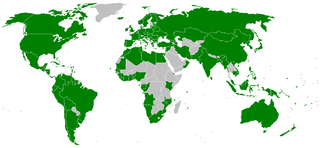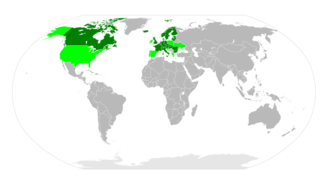The Protocol to the 1979 Convention on Long-Range Transboundary Air Pollution on Further Reduction of Sulphur Emissions is an agreement to provide for a further reduction in sulphur emissions or transboundary fluxes. It is a protocol to the Convention on Long-Range Transboundary Air Pollution and supplements the 1985 Helsinki Protocol on the Reduction of Sulphur Emissions.

Sulfur or sulphur is a chemical element with symbol S and atomic number 16. It is abundant, multivalent, and nonmetallic. Under normal conditions, sulfur atoms form cyclic octatomic molecules with a chemical formula S8. Elemental sulfur is a bright yellow, crystalline solid at room temperature.
The Convention on Long-Range Transboundary Air Pollution, often abbreviated as Air Pollution or CLRTAP, is intended to protect the human environment against air pollution and to gradually reduce and prevent air pollution, including long-range transboundary air pollution. It is implemented by the European Monitoring and Evaluation Programme (EMEP), directed by the United Nations Economic Commission for Europe (UNECE).
The Protocol to the 1979 Convention on Long-Range Transboundary Air Pollution on the Reduction of Sulphur Emissions or their Transboundary Fluxes by at least 30 per cent is a 1985 protocol to the Convention on Long-Range Transboundary Air Pollution agreement that provided for a 30 per cent reduction in sulphur emissions or transboundary fluxes by 1993. The protocol has been supplemented by the 1994 Oslo Protocol on Further Reduction of Sulphur Emissions.
opened for signature - 14 June 1994
entered into force - 5 August 1998
parties - (29) Austria, Belgium, Bulgaria, Canada, Croatia, Cyprus, Czech Republic, Denmark, European Union, Finland, France, Germany, Greece, Hungary, Ireland, Italy, Liechtenstein, Lithuania, Luxembourg, Republic of Macedonia, Monaco, Netherlands, Norway, Slovakia, Slovenia, Spain, Sweden, Switzerland, United Kingdom

Austria, officially the Republic of Austria, is a country of nearly 9 million people in Central Europe. It is bordered by the Czech Republic and Germany to the north, Hungary and Slovakia to the east, Slovenia and Italy to the south, and Switzerland and Liechtenstein to the west. The territory of Austria covers 83,879 km2 (32,386 sq mi). The terrain is highly mountainous, lying within the Alps; only 32% of the country is below 500 m (1,640 ft), and its highest point is 3,798 m (12,461 ft). The majority of the population speaks local Bavarian dialects as their native language, and German in its standard form is the country's official language. Other local official languages are Hungarian, Burgenland Croatian, and Slovene.

Belgium, officially the Kingdom of Belgium, is a country in Western Europe. It is bordered by the Netherlands to the north, Germany to the east, Luxembourg to the southeast, France to the southwest, and the North Sea to the northwest. It covers an area of 30,688 square kilometres (11,849 sq mi) and has a population of more than 11.4 million. The capital and largest city is Brussels; other major cities are Antwerp, Ghent, Charleroi and Liège.

Bulgaria, officially the Republic of Bulgaria, is a country in Southeast Europe. It is bordered by Romania to the north, Serbia and North Macedonia to the west, Greece and Turkey to the south, and the Black Sea to the east. The capital and largest city is Sofia; other major cities are Plovdiv, Varna and Burgas. With a territory of 110,994 square kilometres (42,855 sq mi), Bulgaria is Europe's 16th-largest country.
countries that have signed, but not yet ratified - (3) Poland, Russia, Ukraine

Poland, officially the Republic of Poland, is a country located in Central Europe. It is divided into 16 administrative subdivisions, covering an area of 312,696 square kilometres (120,733 sq mi), and has a largely temperate seasonal climate. With a population of approximately 38.5 million people, Poland is the sixth most populous member state of the European Union. Poland's capital and largest metropolis is Warsaw. Other major cities include Kraków, Łódź, Wrocław, Poznań, Gdańsk, and Szczecin.

Russia, officially the Russian Federation, is a transcontinental country in Eastern Europe and North Asia. At 17,125,200 square kilometres (6,612,100 sq mi), Russia is the largest country in the world by area, covering more than one-eighth of the Earth's inhabited land area, and the ninth most populous, with about 146.77 million people as of 2019, excluding Crimea. About 77% of the population live in the western, European part of the country. Russia's capital, Moscow, is the largest metropolitan area in Europe proper and one of the largest cities in the world; other major cities include Saint Petersburg, Novosibirsk, Yekaterinburg and Nizhny Novgorod. Extending across the entirety of Northern Asia and much of Eastern Europe, Russia spans eleven time zones and incorporates a wide range of environments and landforms. From northwest to southeast, Russia shares land borders with Norway, Finland, Estonia, Latvia, Lithuania and Poland, Belarus, Ukraine, Georgia, Azerbaijan, Kazakhstan, China, Mongolia and North Korea. It shares maritime borders with Japan by the Sea of Okhotsk and the U.S. state of Alaska across the Bering Strait. However, Russia recognises two more countries that border it, Abkhazia and South Ossetia, both of which are internationally recognized as parts of Georgia.

Ukraine, sometimes called the Ukraine, is a country in Eastern Europe. Excluding Crimea, Ukraine has a population of about 42.5 million, making it the 32nd most populous country in the world. Its capital and largest city is Kiev. Ukrainian is the official language and its alphabet is Cyrillic. The dominant religions in the country are Eastern Orthodoxy and Greek Catholicism. Ukraine is currently in a territorial dispute with Russia over the Crimean Peninsula, which Russia annexed in 2014. Including Crimea, Ukraine has an area of 603,628 km2 (233,062 sq mi), making it the largest country entirely within Europe and the 46th largest country in the world.

The Kyoto Protocol is an international treaty which extends the 1992 United Nations Framework Convention on Climate Change (UNFCCC) that commits state parties to reduce greenhouse gas emissions, based on the scientific consensus that (part one) global warming is occurring and (part two) it is extremely likely that human-made CO2 emissions have predominantly caused it. The Kyoto Protocol was adopted in Kyoto, Japan on 11 December 1997 and entered into force on 16 February 2005. There are currently 192 parties (Canada withdrew from the protocol, effective December 2012) to the Protocol.
Protocol to the 1979 Convention on Long-Range Transboundary Air Pollution Concerning the Control of Emissions of Nitrogen Oxides or Their Transboundary Fluxes, opened for signature on 31 October 1988 and entered into force on 14 February 1991, was to provide for the control or reduction of nitrogen oxides and their transboundary fluxes. It was concluded in Sofia, Bulgaria.
The Protocol to the 1979 Convention on Long-Range Transboundary Air Pollution Concerning the Control of Emissions of Volatile Organic Compounds or Their Transboundary Fluxes is a protocol to the Convention on Long-Range Transboundary Air Pollution which aims to provide for the control and reduction of emissions of volatile organic compounds in order to reduce their transboundary fluxes so as to protect human health and the environment from adverse effects. The protocol was concluded at Geneva, Switzerland.

The International Convention for the Prevention of Pollution from Ships, 1973 as modified by the Protocol of 1978 is one of the most important international marine environmental conventions. It was developed by the International Maritime Organization in an effort to minimize pollution of the oceans and seas, including dumping, oil and air pollution. The objective of this convention is to preserve the marine environment in an attempt to completely eliminate pollution by oil and other harmful substances and to minimize accidental spillage of such substances.

The Convention on the Prevention of Marine Pollution by Dumping of Wastes and Other Matter 1972, commonly called the "London Convention" or "LC '72" and also abbreviated as Marine Dumping, is an agreement to control pollution of the sea by dumping and to encourage regional agreements supplementary to the Convention. It covers the deliberate disposal at sea of wastes or other matter from vessels, aircraft, and platforms. It does not cover discharges from land-based sources such as pipes and outfalls, wastes generated incidental to normal operation of vessels, or placement of materials for purposes other than mere disposal, providing such disposal is not contrary to aims of the Convention. It entered into force in 1975. As of September 2016, there were 89 Parties to the Convention.
An emission inventory is an accounting of the amount of pollutants discharged into the atmosphere. An emission inventory usually contains the total emissions for one or more specific greenhouse gases or air pollutants, originating from all source categories in a certain geographical area and within a specified time span, usually a specific year.
The 1999 Gothenburg Protocol to Abate Acidification, Eutrophication and Ground-level Ozone is a multi-pollutant protocol designed to reduce acidification, eutrophication and ground-level ozone by setting emissions ceilings for sulphur dioxide, nitrogen oxides, volatile organic compounds and ammonia to be met by 2010. As of August 2014, the Protocol had been ratified by 26 parties, which includes 25 states and the European Union.

The Aarhus Protocol on Persistent Organic Pollutants, a 1998 protocol on persistent organic pollutants (POPs), is an addition to the 1979 Geneva Convention on Long-Range Transboundary Air Pollution (LRTAP). The Protocol seeks "to control, reduce or eliminate discharge, emissions and losses of persistent organic pollutants" in Europe, some former Soviet Union countries, and the United States, in order to reduce their transboundary fluxes so as to protect human health and the environment from adverse effects.
This is a list of notable events relating to the environment in 2003. They relate to environmental law, conservation, environmentalism and environmental issues.
This is a list of notable events relating to the environment in 1997. They relate to environmental law, conservation, environmentalism and environmental issues.
The Convention on the Transboundary Effects of Industrial Accidents is a United Nations Economic Commission for Europe (ECE) convention signed in Helsinki, Finland, on 17 March 1992, that entered into force on 19 April 2000. The Convention is designed to protect people and the environment against industrial accidents. The Convention aims to prevent accidents from occurring, or reducing their frequency and severity and mitigating their effects if required. The Convention promotes active international cooperation between countries, before, during and after an industrial accident.
This is a list of notable events relating to the environment in 1991. They relate to environmental law, conservation, environmentalism and environmental issues.
This is a list of notable events relating to the environment in 1987. They relate to environmental law, conservation, environmentalism and environmental issues.
The Convention on the Protection and Use of Transboundary Watercourses and International Lakes, also known as the Water Convention, is an international environmental agreement and one of five UNECE's negotiated environmental treaties. The purpose of this Convention is to improve national attempts and measures for protection and management of transboundary surface waters and groundwaters. On the international level, Parties are obliged to cooperate and create joint bodies. The Convention includes provisions on: monitoring, research, development, consultations, warning and alarm systems, mutual assistance and access as well as exchange of information.
Emission Control Areas (ECAs), or Sulfur Emission Control Areas (SECAs), are sea areas in which stricter controls were established to minimize airborne emissions from ships as defined by Annex VI of the 1997 MARPOL Protocol.
Sulphur Emissions Reduction Protocol may refer to:
The Protocol on Heavy Metals, a protocol to the Convention on Long-Range Transboundary Air Pollution, was adopted in Aarhus, Denmark in 1998. As of 2004, it had 36 signatories. As of 2016, it had 35 signatories and 33 parties, with no country having become a signatory since 1998. The protocol addresses the reduction of cadmium, lead and mercury emissions in the interests of environmental protection. Amendments to the Protocol were agreed in 2012 to introduce more stringent emission limits but are not yet in force.










